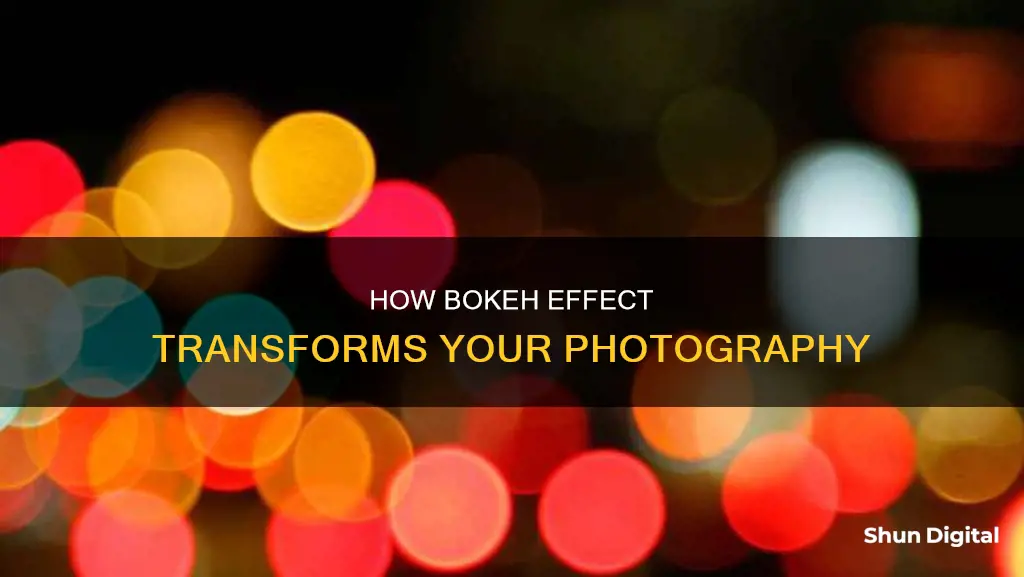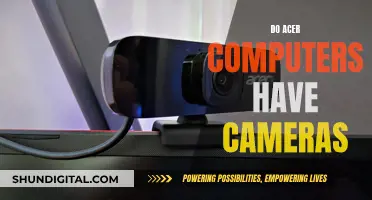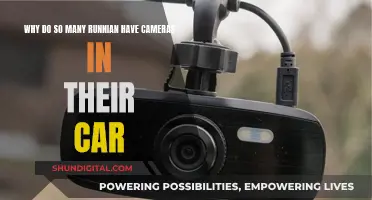
The visual focus effect on cameras is called focus or camera focus. It is a fundamental concept in photography and cinematography, and it refers to the process of adjusting the lens to achieve the desired sharpness and clarity in an image. Focus can be achieved manually by the photographer or cinematographer, or automatically by the camera's autofocus system. Proper focusing ensures that the intended subject is sharp and detailed, while the background may be blurred to varying degrees depending on the desired effect. Focus plays a crucial role in visual storytelling, allowing directors and cinematographers to guide the audience's attention, convey emotions, and reveal important details.
What You'll Learn

Manual focus vs autofocus
The visual effect of focusing on cameras is called "focus" or "depth of field". This effect can be achieved through manual focus or autofocus.
Manual focus and autofocus are two methods of achieving focus in photography. While autofocus is more common in modern digital cameras, manual focus is also used in certain situations. Here is a detailed comparison between the two:
Manual Focus:
- Definition: Manual focus is a technique where the photographer manually sets the focus by adjusting the focus ring of the camera.
- Usage: Manual focus is less commonly used than autofocus. However, it is particularly useful when the camera struggles to focus automatically or when taking a series of images where focus needs to remain constant.
- Advantages: Manual focus offers greater creative control to the photographer. It is ideal for situations where autofocus may struggle, such as low-light conditions, shooting through glass or fences, or when there are many objects in the scene. It also excels in macro photography, deep landscape photography, and astrophotography.
- Disadvantages: Manual focus is generally slower than autofocus, making it less suitable for capturing moving subjects or action scenes.
Autofocus:
- Definition: Autofocus is a feature in most digital cameras that automatically sets the focal point, allowing the camera to ensure a clear shot.
- Usage: Autofocus is typically the default choice for photographers due to its convenience and speed. It is well-suited for capturing moving subjects and action scenes.
- Advantages: Autofocus is generally faster and more convenient than manual focus. Recent advancements include tracking, which locks focus on a subject and tracks it through the frame, making it ideal for sports, wildlife, and bird photography. Autofocus also excels in situations with low contrast, where manual focus may struggle.
- Disadvantages: Autofocus may struggle in certain conditions, such as low-light environments, scenes with many objects, or when shooting at high magnifications (macro photography). It is also less precise than manual focus, which can be an issue in genres like landscape and portrait photography.
In conclusion, the choice between manual focus and autofocus depends on the photographer's needs and shooting conditions. While autofocus is generally faster and more convenient, manual focus offers greater creative control and performs better in certain challenging situations.
Unveiling Camera Brick Battery's Inner Workings
You may want to see also

Phase detection vs contrast detection
The visual focus effect on cameras is called autofocus. Autofocus refers to the mechanism that automatically moves the elements within the lens to achieve the best focus. This is done through a series of autofocus points that are visible through the viewfinder. There are two types of autofocus systems: phase detection and contrast detection.
Phase detection autofocus is the system most commonly found in DSLR cameras. In this system, light passes through the lens, hits a reflex mirror, and is reflected up through a pentaprism and out through the viewfinder. The centre of the camera's mirror is translucent, and a sub-mirror behind it reflects light down into the base of the camera body, where the autofocus sensor unit is positioned. This autofocus unit contains a sensor that corresponds to the camera's autofocus points.
In phase detection autofocus, the light reflected from the sub-mirror is split into two separate images by prisms and microlenses in the autofocus sensor unit, each aimed at two lines on the autofocus sensor corresponding to the active autofocus point. If the images hit these two lines precisely, the subject is in focus. The distance between the two images tells the camera how much the lens is out of focus, and the camera then drives the lens to the correct position. This system is very fast, making it great for tracking moving objects, but it may not be able to focus accurately on low-contrast subjects or in low light.
Contrast detection autofocus is commonly used in mirrorless cameras, point-and-shoot cameras, DSLR cameras in live view mode, and smartphone cameras. This system uses the light falling on the main sensor to provide focus. Contrast detection autofocus works by analysing pixels on the camera's sensor and finding the point of maximum contrast, which is when the subject is in focus. This system is much simpler than phase detection and can have an almost unlimited number of autofocus points. However, it is slower than phase detection as the camera must constantly evaluate images to achieve focus.
Some cameras use a hybrid of the two systems. For example, a digital single-lens reflex (SLR) camera may use contrast detection autofocus in live view or movie mode and phase detection autofocus when you look through the viewfinder.
Speeding Ticket Camera Fines in Maryland: How Much?
You may want to see also

Continuous vs single-servo autofocus
The visual focus effect on cameras is called autofocus. Autofocus refers to the mechanism that automatically moves the elements within the lens to achieve the best focus. This is done through a series of autofocus points that are visible through the viewfinder. The camera (or photographer) selects a particular focus point and this is used to achieve focus.
There are different types of autofocus modes: single-servo autofocus and continuous-servo autofocus.
Single-servo autofocus, also known as single-shot autofocus, is best suited for shooting subjects that are not in motion. When the shutter button is pressed halfway, the autofocusing is activated and once complete, the focus is locked. So if you keep your finger on the button, no adjustments are made, even if you decide to recompose the shot and move the camera.
In contrast, continuous-servo autofocus is designed for shooting moving subjects. In this mode, the camera continuously tracks the subject's movement and adjusts the focus accordingly. Whenever the shutter button is pressed or half-pressed, the autofocus will continually change the focus to keep the subject sharp, even if the subject or photographer are moving. This makes it especially useful when shooting action photos of moving subjects or when shooting at super-shallow apertures.
Both single-servo and continuous-servo autofocus have their advantages and limitations. Single-servo autofocus is ideal for static subjects where the focus needs to remain locked, while continuous-servo autofocus is more suitable for capturing moving subjects and ensuring they remain in focus.
Charging Your Sanyo E1090: Quick and Easy Guide
You may want to see also

Autofocus area modes
Autofocus (AF) area modes are an essential feature of modern digital cameras, allowing photographers to fine-tune how and where the camera focuses within a scene. The right AF area mode can help nail autofocus and take sharper photos.
Single-Point AF Area Mode
Single-Point AF Area mode allows photographers to select a single focus point for static elements within a scene. The camera will automatically adjust focus to keep the sharpness of the image as long as the subject remains framed over this point and AF-C is selected. Basic camera models typically include just a few focus points, while advanced models include more focus points for better precision.
Dynamic AF Area Mode
Dynamic AF Area mode enables photographers to manually select a focus point. If the subject moves, the camera uses this point and the surrounding points to keep the subject sharp. Most cameras include different dynamic AF area modes, such as 9, 21, or 51 points. Dynamic AF area mode is ideal for wildlife and sports/action photography.
Group AF Area Mode
Group AF area mode allows photographers to select a specific autofocus area with multiple autofocus points to focus on a particular subject or zone. It is well-suited for wildlife and sports photography, as well as group shots in portraiture.
Auto AF Area Mode
Auto AF Area mode is a completely automatic mode where the camera decides which focus points to use based on factors such as subject distances, motion relative to the camera, and the presence of detectable eyes. This mode is useful for novice photographers or situations requiring quick focus on nearby objects. However, it is not recommended when more control over the focus point is needed.
Different camera manufacturers may use different terms for similar AF settings. For example, Nikon refers to its modes as AF-S (Single autofocus), AF-C (Continuous autofocus), and AF-A (Hybrid autofocus), while Canon uses One-Shot AF, AI Servo AF, and AI Focus AF, respectively. It is important to refer to the camera's instruction manual to understand the specific AF area modes available and how to select them.
Reviving Dionic Camera Batteries: Charging Tips and Tricks
You may want to see also

Depth of field
The visual focus effect on cameras is called "depth of field" (DoF). It refers to the range of distance that appears acceptably sharp in an image. The transition from sharp to unsharp is gradual, and the term "acceptably sharp" is subjective and depends on factors like how the image will be viewed, the size of the image, and the viewer's vision.
Understanding depth of field is crucial in photography as it allows photographers to control the sharpness and blur in their images, creating a desired visual effect.
Hyperlapse Camera Mode: Capturing Time in a Creative Way
You may want to see also
Frequently asked questions
The visual focus effect on cameras is called "camera focus".
There are six types of camera focus: deep focus, shallow focus, soft focus, rack focus, split diopter, and tilt-shift.
Camera focus works by manipulating the depth of field, which refers to the area around a subject that appears to be in focus. This can be achieved by changing the focal length of the lens, adjusting the aperture, or physically changing the distance from the subject.
Camera focus can be used to direct the audience's attention, create tension and suspense, establish relationships between characters, and enhance the production design, lighting, and set decoration.







